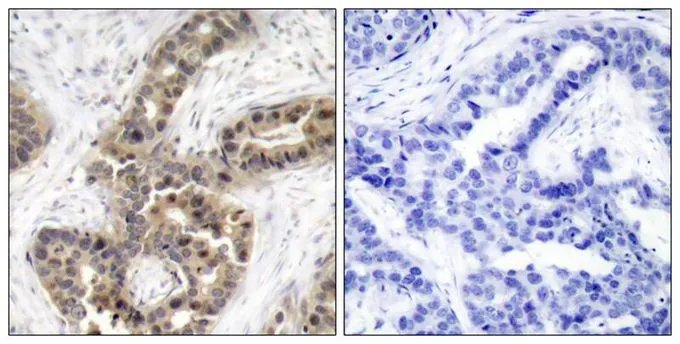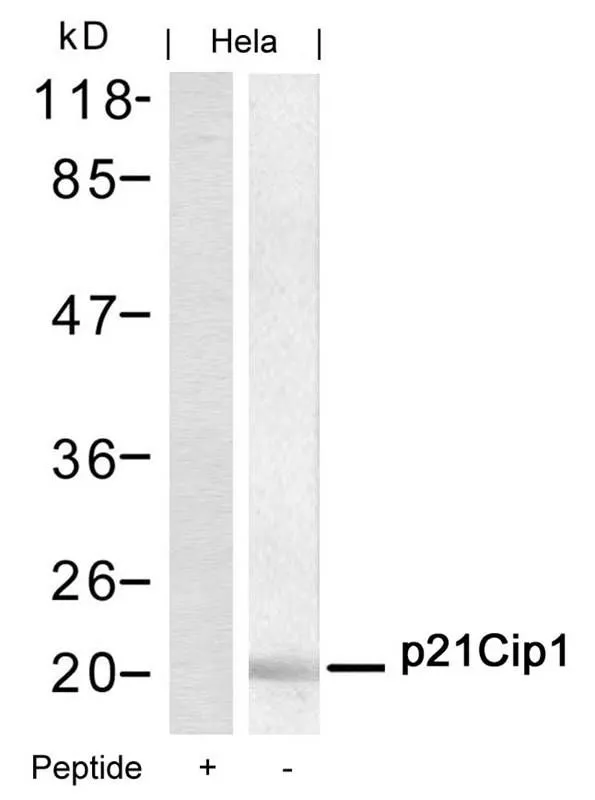![IHC-P analysis of human urothelial carcinoma section using GTX02619 p21 Cip1 antibody [CIP1/2275R]. IHC-P analysis of human urothelial carcinoma section using GTX02619 p21 Cip1 antibody [CIP1/2275R].](https://www.genetex.com/upload/website/prouct_img/normal/GTX02619/GTX02619_20210319_IHC-P_w_23053122_613.webp)
IHC-P analysis of human urothelial carcinoma section using GTX02619 p21 Cip1 antibody [CIP1/2275R].
p21 Cip1 antibody [CIP1/2275R]
GTX02619
ApplicationsWestern Blot, ImmunoHistoChemistry, ImmunoHistoChemistry Paraffin
Product group Antibodies
ReactivityHuman
TargetCDKN1A
Overview
- SupplierGeneTex
- Product Namep21 Cip1 antibody [CIP1/2275R]
- Delivery Days Customer9
- Application Supplier NoteWB: 1-2 microg/ml. IHC-P: 1-2 microg/ml. *Optimal dilutions/concentrations should be determined by the researcher.Not tested in other applications.
- ApplicationsWestern Blot, ImmunoHistoChemistry, ImmunoHistoChemistry Paraffin
- CertificationResearch Use Only
- ClonalityMonoclonal
- Clone IDCIP1/2275R
- Concentration200 ug/ml
- ConjugateUnconjugated
- Gene ID1026
- Target nameCDKN1A
- Target descriptioncyclin dependent kinase inhibitor 1A
- Target synonymsCAP20, CDKN1, CIP1, MDA-6, P21, SDI1, WAF1, p21CIP1, cyclin-dependent kinase inhibitor 1, CDK-interacting protein 1, CDK-interaction protein 1, DNA synthesis inhibitor, cyclin-dependent kinase inhibitor 1A (p21, Cip1), melanoma differentiation associated protein 6, wild-type p53-activated fragment 1
- HostRabbit
- IsotypeIgG
- Protein IDP38936
- Protein NameCyclin-dependent kinase inhibitor 1
- Scientific DescriptionThis gene encodes a potent cyclin-dependent kinase inhibitor. The encoded protein binds to and inhibits the activity of cyclin-cyclin-dependent kinase2 or -cyclin-dependent kinase4 complexes, and thus functions as a regulator of cell cycle progression at G1. The expression of this gene is tightly controlled by the tumor suppressor protein p53, through which this protein mediates the p53-dependent cell cycle G1 phase arrest in response to a variety of stress stimuli. This protein can interact with proliferating cell nuclear antigen, a DNA polymerase accessory factor, and plays a regulatory role in S phase DNA replication and DNA damage repair. This protein was reported to be specifically cleaved by CASP3-like caspases, which thus leads to a dramatic activation of cyclin-dependent kinase2, and may be instrumental in the execution of apoptosis following caspase activation. Mice that lack this gene have the ability to regenerate damaged or missing tissue. Multiple alternatively spliced variants have been found for this gene. [provided by RefSeq, Sep 2015]
- ReactivityHuman
- Storage Instruction2°C to 8°C
- UNSPSC12352203

![WB analysis of HeLa whole cell lysate using GTX02619 p21 Cip1 antibody [CIP1/2275R]. WB analysis of HeLa whole cell lysate using GTX02619 p21 Cip1 antibody [CIP1/2275R].](https://www.genetex.com/upload/website/prouct_img/normal/GTX02619/GTX02619_20210319_WB_w_23053122_964.webp)



![IHC-P analysis of squamous cell carcinoma tissue using GTX01859 p21 Cip1 antibody [4D10].](https://www.genetex.com/upload/website/prouct_img/normal/GTX01859/GTX01859_20200811_IHC-P_66_w_23053121_557.webp)